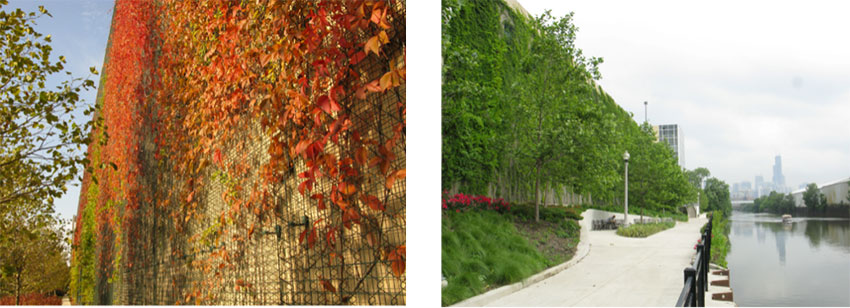People like to be outdoors, especially when the weather is inviting. Recognizing this, many building owners are asking architects and other design professionals to incorporate specific outdoor spaces into an overall building design. This is true for mixed-use spaces where restaurants or taverns are looking for well-designed outdoor seating areas. It is also true for multifamily residences with common outdoor areas for active recreation or quiet reading and reflection. Even single-family homes are embracing the concept of a well-designed outdoor space that connects the outdoor environment directly to the building it is associated with. This course looks at some of the trends in designing such outdoor living spaces and specific ways that they can be successfully incorporated into projects of all types.
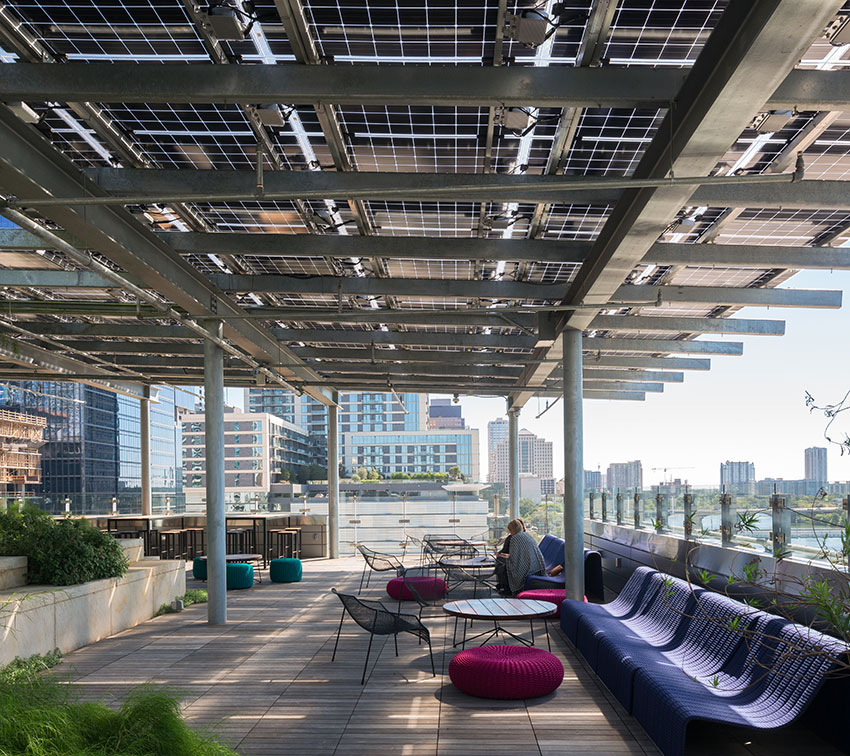
Photo courtesy of Leonid Furmansky; Bison Innovative Products
In many buildings, good design includes outdoor spaces that help improve the health and well-being of the people using them as well as providing benefits to the building owners.
OUTDOOR PAVED AREAS
Most buildings need vehicular and pedestrian access that create intentional or de facto outdoor spaces around those buildings. The common choice is to use asphalt or concrete paving for hardscape surfaces and vegetated surfaces around that, either in the form of grasses, planting, landscaped beds, etc. The concern with the paving, however, is its lack of permeability which leads to design issues of water runoff, retention, and drainage. Not only is it a matter of managing the water, but there is also a legitimate concern about the things transported by the water runoff, such as petroleum products from parked cars, chemicals from landscaping, or other harmful compounds.
In response to this situation, alternatives have been developed in the form of permeable paving systems to replace traditional hard surfaces. These systems use a range of materials and techniques that allow the movement of stormwater through the surface down into the underlying base and subbase. A variety of plant-able and non-planted systems are available that have been shown to help reduce the carbon footprint of buildings, improve water quality, diminish flooding and erosion, and reduce urban heat islands all while creating attractive open spaces.
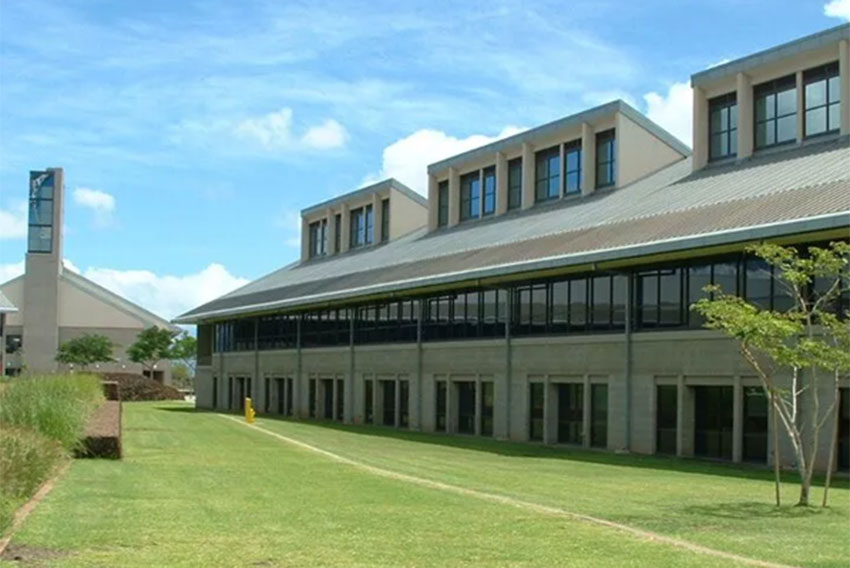
Photo courtesy of Invisible Structures
Porous paving can have a traditional, gravel, or grassy appearance depending on the type of system used.
What Is Porous Paving?
In the most generic sense, porous paving is a specific type of surface pavement or under-surface paving structure that allows rainfall or water run-off to penetrate the surface to the sub-surface below. Intentional voids in the subsurface fill with water and penetrate the soil below thus addressing stormwater issues. Harmful stormwater runoff can occur when a surface is impervious while porous paving allows for infiltration. Depending on the amount of void space, depth, and composition of the base course, a large amount of run-off may be captured in a small area. Engineered systems provide the strength required to support a range of traffic conditions from pedestrian traffic to heavy-duty vehicular traffic including emergency and even aeronautical vehicles. Certain permeable paver systems are designed to support traffic loads, protecting the surface from compaction, and thus eliminating surface rutting.
There are four fundamentally different types of porous paving systems available. The first one is to specify permeable concrete or asphalt which maintains spaces between the aggregate to intentionally allow water infiltration into the substrate. Such porous pavement is installed in a manner similar to conventional concrete or asphalt paving but requires additional attention to the subbase to function properly. There are also three types of manufactured porous pavers that are designed to be set in place on a sub-base. Different products are designed to be either filled with gravel or with topsoil and grass to create a green, planted look. Such manufactured products include concrete paving blocks, rigid plastic porous pavers, and flexible plastic porous pavers. We look more closely at these four choices further on in this course.
Benefits of Using Porous Paving
Regardless of the type of system used, there are several very good reasons to use porous paving in a project. Some of the common ones include the following:
- Sustainable Outdoor Spaces: Porous paving can be an important component in the design of green spaces for sustainable buildings by creating multifunctional outdoor spaces that can also withstand traffic. This helps increase the exterior aesthetics by creating outdoor, planted, or even park-like areas that can visually soften the landscape.
- Traffic Support: For areas that require pedestrian or vehicular traffic, porous paving systems provide the needed structural support. Concrete or asphalt porous paving provides a more traditional, albeit somewhat textured look while paving systems offer different aesthetics and different loading capabilities. Some plastic porous pavers, for example, cannot support the weight of firetrucks or other heavy-weight vehicles. Some others work well to provide emergency access to buildings when needed but can otherwise look like a grassy, open area with the pavers concealed beneath the growth.
- Controlling Stormwater: Porous pavers are a simple, yet incredibly effective way to address stormwater issues. Because all porous paving offers some void space beneath the surface it reduces flooding and runoff. This water absorption reduces flooding and provides protection against erosion of the soil in adjacent areas. In some cases, stormwater can be captured and used for non-potable purposes such as irrigation.
- Filter Toxins and Pollutants: In certain porous paving systems, the water is naturally filtered and recharges the ground water/ aquifer. This natural process removes airborne and water-based toxins through natural filtration and bio-mediation, all of which reduce pollution from runoff. Pavers planted with grass also reduce airborne CO2 levels like all planted material through photosynthesis.
- Urban Heat Island Control: By replacing concrete and asphalt with grass or gravel porous paving, heat can be reduced in urban areas by providing more natural, less heat-absorbing materials. The increase of “heat islands” in urban areas is attributed to the abundance of asphalt, concrete, and glass in urban buildings. Porous pavement, particularly with planted grass, can mitigate these urban heat islands and reduce the overall temperatures.
- Sound Control: Porous paving can help create quieter outdoor areas. It can reduce noise because of the void spaces within the subsurface. When sound waves enter from vehicles or other sources, the voids help absorb the sound energy so less is reflected out to the surrounding area.
- Accessibility: Some porous pavers have been tested and approved to meet accessibility and ADA requirements. Flexible porous mats can be used which are forgiving with gradients and undulations on the surface, making wheel rotation easy and smooth. For such applications, it is recommended not to overfill fill the openings in the pavers but only to the top using a sharp angular aggregate for best traction.
- LEED Contributions: Grass and gravel porous pavers can contribute to LEED points on green building projects in several ways related to credits in the Sustainable Sites category. Depending on the type of porous paving chosen, LEED points can be earned for landscape and exterior design that reduces heat islands (non-roof). Note that this is not applicable for porous concrete and asphalt, but can be earned with certain porous paver systems, particularly with planted material. There are also credits available for surface water management by demonstrating the reduction of post-development stormwater run-off compared to a baseline – the greater the reduction, the greater the number of points earned. In some cases, earning certification points with the Sustainable Sites Initiative (SITES) is used as a basis for earning LEED points. Note that a porous paving system can also be a key component to earning an independent SITES certification for a project as well. Additional points are available if the porous paving is linked with a green infrastructure system to further control rainwater.
Relatedly, some manufacturers of plastic porous paving systems are committed to using recycled content in their products, with at least one offering 100 percent recycled plastic content across the United States and abroad. Creating plastic from reprocessed resins requires 88 percent less energy than creating plastic with raw gas or oil─1 ton of recycled plastic saves 16.3 barrels of oil, significant processing energy, and 30 cubic yards of landfill space.
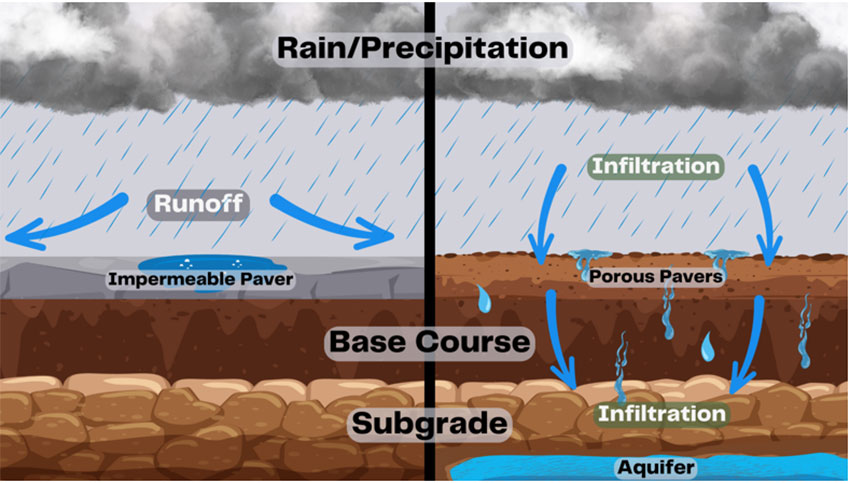
Image courtesy of Invisible Structures
Compared to conventional, impermeable materials, porous paving allows for more natural control and management of stormwater.
OUTDOOR DECK AREAS
In many cases, the best way to create outdoor living space is to look for areas where a deck can be incorporated either at grade level or an elevated level such as at balconies or rooftops. These types of outdoor spaces can allow for an extension of indoor areas or can be seen as outdoor places all on their own. Through design, such outdoor deck areas can be completely customized to contain desirable amenity features such as outdoor kitchens, fire pits, bars, seating areas, gardens, or others.
One successful means to construct this type of outdoor space is to use a modular, raised pedestal deck system. This versatile approach gives designers the flexibility to create unique and beautiful outdoor spaces. Adjustable pedestal deck systems can be utilized over virtually any structural surface - on bare structural decks, rooftop decks, roof membranes, green roofs, terraces, compacted grade, pavement, or pool surrounds. The adjustable pedestal accessories allow for variations in slope or substrate so a level pedestal grid can be created. On top of that, modular wood tiles or other pavers can then be laid to create the outdoor walking surface. Architects can choose from a mix of surface material options including wood, stone, structural porcelain, crushed rock, grating, artificial turf, and concrete. In addition, some systems readily accommodate other features such as planter cubes, water features, exterior lighting, and benches, to create a complete living or entertaining space. Through the modular use of materials and accessories, designers can create an abundance of different design visions without the need for custom or costly materials.
In addition to being readily customized to suit a particular design intent, this modular, adjustable approach helps connect people to the outdoor environment. Outdoor decks can also provide a direct visual and material connection with nature thus creating a peaceful refuge to rejuvenate the body, mind, and soul. A deck’s views of the encircling landscape can provide users the opportunity to visually survey and contemplate the surrounding environment. These broad landscape views can inspire an emotional attachment to the building’s natural surroundings and promote positive interactions between the building users and the neighboring ecosystem.
From a biophilic standpoint, natural materials can be used in a deck system, such as wood and stone, and the spaces can incorporate vegetation and greenery using planter cubes and pots. This allows for regular interactions with the outdoors which has been proven to have positive health benefits, such as lower blood pressure, reduced stress, expedited healing, and improved mood. These areas can also provide occupants with the opportunity to release tension through sport and physical activity, thereby improving users’ focus, health, and morale.
Modular deck systems can also contribute to sustainable design goals and may help projects earn certification through LEED, SITES, WELL, and other green building programs. Specifically, they may help to reduce a building’s carbon footprint through a reduction in a roof’s ambient temperature, provide the potential for green space, become part of a rainwater collection system, or help reduce the need for roof replacement, thus extending the service life of the roofing.
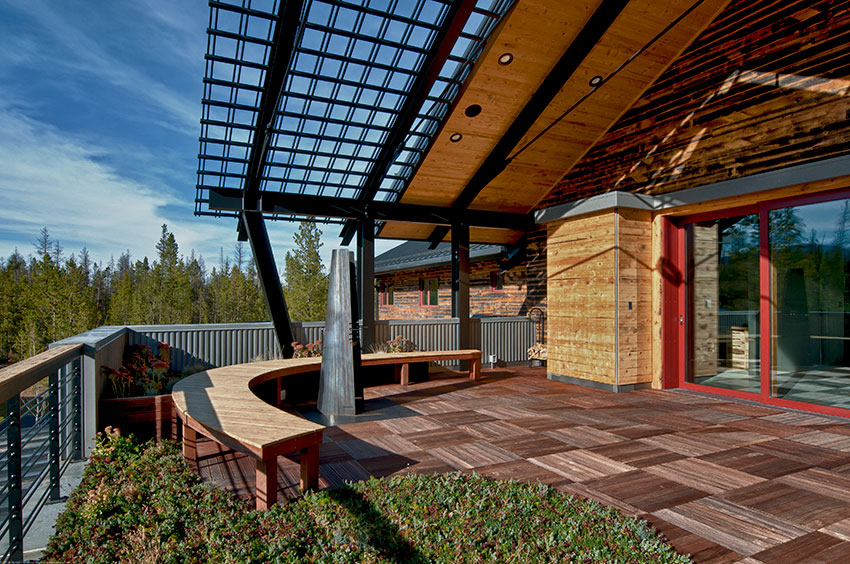
Photo courtesy of Bison Innovative Products
The creative use of an outdoor deck helps connect indoor and outdoor spaces by opening up views and claiming space that might otherwise go underused as shown here at the Frasier House in Boulder, Colorado, a net-zero energy building.
Designing with Modular Deck Systems
One of the biggest opportunities of a modular, adjustable deck system is to be able to use underutilized outdoor spaces. That means design professionals can turn an otherwise wasted space into a functional outdoor amenity or an attractive and sustainable feature of the building. For example, incorporating a pedestal system can provide pedestrian access to green roofs. There, native plants and natural building materials offer occupants a visual and physical connection with the natural environment that might not otherwise exist. Further, modular planters can provide a space for seasonal growing, offering an even more direct interaction with nature and a potential connection to fresh food sources.
Other features can also be part of a successful outdoor deck design. Where nighttime use is desired, designs can include recessed lighting to enhance the ambiance of the deck area and improve visibility and safety. Water ponds or fountains can similarly be incorporated since adjustable pedestal systems are ideal for such features. The deck system conceals the water supply beneath the surface materials and allows water to drain to the surface below for recycling. Additionally, when high-quality plastic supports are used, they are impervious to water, mold, and most chemicals. This permeability of the system also helps reduce energy loads on the building by keeping the roofing surface cooler and well ventilated.
The modular design of these systems contributes to a fairly quick and easy installation, keeping the construction economical and budget friendly. Fastening kits facilitate swift and secure installations of deck surface materials such as wood tiles and paver tray-backed pavers. Built-in bottom slope-leveling mechanisms provide pedestal stability and adjustability, even once loaded. Tab sets on each pedestal allow for consistent tile or paver spacing.
LIVING WALLS
utdoor spaces are created and defined by more than just horizontal surfaces. Often architects think that exterior vertical wall materials or features need to be used but there are natural options too. In particular, the notion of green infrastructure has re-emerged as a priority in the built environment. Essentially, this concept relies on the centuries-old use of natural, living plants incorporated into buildings to reap multiple benefits. Of course, those benefits rely on actual, living plants being used. Sometimes, the term “greenwall” is used to describe what appears to be a vertical growth of vegetation growing on the interior or exterior of a building supported by a trellis. Such installations do not always use living plants but instead use artificial ones simply to create a natural “look” or attempt to incorporate biophilia (i.e., a natural-looking element added to a building) into a design. In order to be clear, we will use the term “living wall” which refers to real, living plants or vines that require sunlight and water to grow up along an intentionally designed trellis structure on a building.
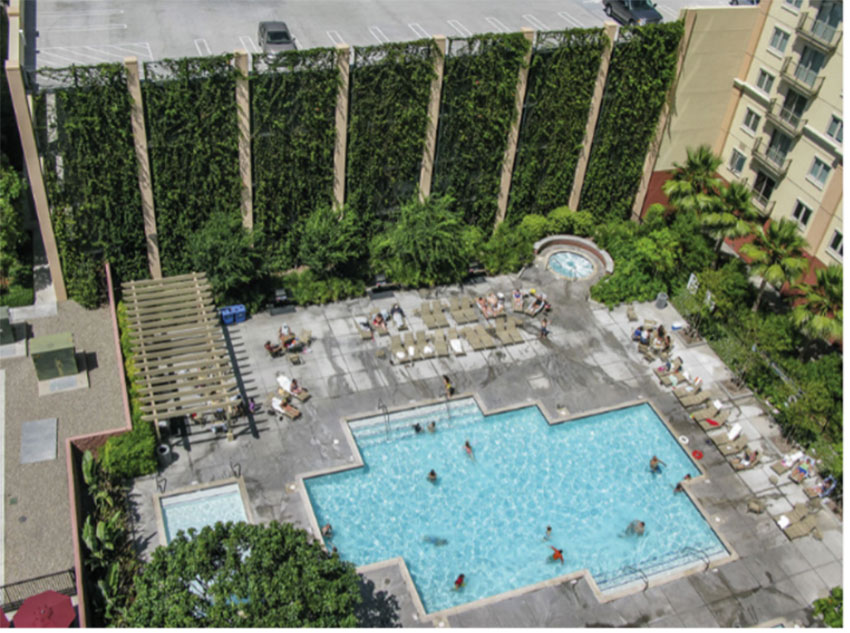
Photo courtesy of Greenscreen
The use of natural, living, green walls helps create an outdoor space with numerous benefits to the end user as shown here at the Worldmark at Trendwest in Anaheim, California.
The benefits of such living walls are numerous but include the following fundamental ones:
- True Biophilic Design: Biophilia does not mean brief isolated exposures to nature but repeated sustained engagement. Biophilic design should also enable ease of interaction within the space to foster connections and community and give us a meaningful context. The use of real, natural vines that can grow in the locality where they are planted meet these criteria. Plastic plants may provide the look of live plants but can’t offer the full biophilic experience and benefits to the environment.
- Reduction of the Heat Island Effect: Living walls absorb sunlight and provide natural evapotranspiration which is nature’s way of keeping the surrounding temperature comfortable. This is one of the proven benefits of green infrastructure that has been used all over the world.
- Energy Savings: Living walls and living green roofs cool a building both through the evapotranspiration described above, but also from simple shading. This cooling leads to building energy savings as the building gets directly cooled by the living plants instead of relying solely on air-conditioning units.
- Carbon capture: Living wall trellis systems absorb carbon dioxide just like all living plants and in turn give off oxygen through photosynthesis. They also provide natural carbon capture due to carbon assimilation into the woody stem biomass. Green walls that use plastic plants are made from petrochemicals and have a terrible carbon budget.
- Stormwater: Real plants absorb vast quantities of rainwater that never have to be fed into the stormwater system. For living green roofs, this can be 30-70% of the annual precipitation depending on the profile and climate. This retention capacity results in lower stormwater drainage costs in addition to the money saved through energy savings for pumps where needed.
- Mental health: Green infrastructure creates environments that have been shown to be good for both the environment and the human mind. There has been a lot of research conducted that indicates how humans feel better in a natural setting. This can lead to cost savings associated with fewer workdays missed by employees and patients released earlier from hospitals. In essence, people simply feel healthier in natural, green surroundings.
- Pollution Capture: Air pollution is a significant concern in many settings, particularly since it has been cited as the fourth leading global risk factor for death. Living walls are an excellent design response to this concern since they naturally provide pollution capture. It has been shown that the greening of external walls can reduce harmful particulate matter (PM2.5) by 11 to 31 percent and Nitrogen Dioxide (NO2) by 7 percent to 20 percent.
Many of these traits and benefits also help living walls contribute to earning credits in green building programs such as LEED and others.
Design Options for Living Walls
Like most sustainable building components, there are different ways to include living walls and green infrastructure in buildings. While all may have different design, installation, and maintenance considerations, each of the following design options can help designers achieve both aesthetic and sustainability goals, including improved energy performance in buildings:
- Living Green Walls: Living wall trellis systems can be used to create soft-textured vine-covered seasonally changing surfaces, commonly referred to as “green facades.” Manufacturers of trellis systems used for this purpose generally offer engineered mounting accessories designed to hold trellis panels off the building surface. This protects the building’s cladding from direct plant attachment and transfers the weight of the plants to the screen structure and the wall attachments. Panels can be stacked side to side or top to bottom to cover larger areas.
- Fencing: Sometimes, instead of a wall, a separate, stand-alone vertical surface is desired for enclosure or fencing. In this case, lightweight but strong trellis panels can be placed between appropriate supports to “capture” plant material and provide the benefits of a living fence enjoyed from both sides. This approach can be simple, or complex based on the nature of the design, but modular components help facilitate easier installations.
- Infill/Overhead: Vegetated trellis panels can be placed overhead on traditionally built flat or curved frameworks to create a more immersive experience. This approach can create shade for an outdoor space, provide more privacy, and mitigate views based on the leaf canopy of the plant selected. The trellis panels can be used as infill and be custom tapered, notched, mitered, or curved for unique configurations using standard attachments.
- Columns: In some cases, free-standing columns that may support an overhead structure are the desired surface onto which to add vegetation. Standard column trellis panels are typically a 15 ½”-diameter column up to 14 feet high as a basic building element. Custom diameters and heights are possible by checking directly with manufacturers. Mounting clips or brackets may also be provided for attaching to the structure.
- Planters: For projects that require freestanding containers, trellis panels can be mounted to rectangular planters in multiple configurations. Some column trellis products also coordinate with cylindrical planters or can be adapted to posts or columns of various diameters. Planters can be incorporated onto rooftops, used as patio dividers, or help to define outdoor spaces.
- Custom: Living trellis panels are commonly based on a modular 2”x2” design which allows them to be easily customized to meet a wide variety of project requirements. At least one manufacturer uses such three-dimensional panels fabricated from a welded wire grid separated by a bent wire truss welded every 2 inches, resulting in rigid, yet lightweight and customizable panels. They can be cut at angles, mitered, notched, spliced, or curved. The panels can span openings or attach to support frames. In combination with standard or custom edge trim and engineered mounting hardware, unique applications are limited only by the imagination of the designer.
With this variety of design options, it is readily possible to incorporate living components into many outdoor spaces.

Photos courtesy of Greenscreen
Green features based on modular, trellis-type systems can be used in a variety of ways to create and define outdoor spaces.
DESIGNING WITH DIFFERENT TYPES OF POROUS PAVING
All porous paving systems are designed to transfer the weight of pedestrians or vehicles while maintaining the integrity of the surface, although some can carry more weight than others. Porous paving systems also have varying degrees of void space which means that the water will pass through at different rates. As noted earlier, there are four fundamental types of types of porous paving systems – 1.) Porous concrete or asphalt, 2.) concrete paving blocks, 3.) rigid plastic porous pavers, and 4.) flexible plastic porous pavers.
All systems have similar components after the site is excavated down to the existing subgrade soil as follows:
- Base Course: The specified base course of a permeable paving system is one of the most essential elements of the system itself. The recommended depths and composition must be sufficient to accommodate not just the load of the traffic, but the potential flood of stormwater without maintenance or future retrofitting. The deeper the base course, the stronger and greater space for water storage. The base course should be composed of at least 70% gravel/stone material, and the rest should be sand, for ultimate support and porosity. Base course depth recommendation will vary by use, some requiring a very shallow 2” for pedestrian and light stormwater capture – to depths of 12” for heavy stormwater drainage, and to satisfy Fire Departments for Heavy Fire Trucks.
- Void Space: Void space is what determines the flow rate – it equals the percentage of water or air that can pass through a product. The amount of void space is an important consideration when choosing a system because higher void space will create a faster flow rate. For example, porous asphalt may only have a 16 percent void space while flexible porous pavers can have up to 96 percent.
- Porous Paving: If porous concrete or asphalt is used as the final paving, then it is placed appropriately over the base course. If concrete paving blocks are used, they are placed and spaced as called for in the design. If porous plastic pavers are used, they are installed with structural fill in the form of gravel aggregate or soil and grass to create the final surface.
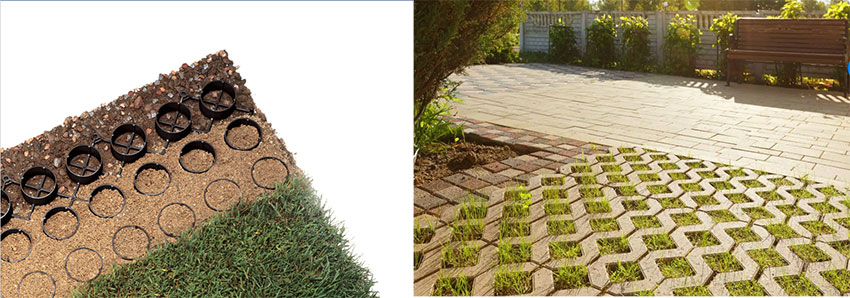
Photos courtesy of Invisible Structures
Plastic or concrete porous paver systems are laid over a base course with appropriate void space and then filled with a choice of gravel, grass, or other porous material.
All porous pavers are an environmentally better design choice than traditional concrete or asphalt. However, prioritizing the most important elements of a project can determine which type of paver is the best option. What makes porous paving products different from one another? The structures themselves vary in material, size, shape, and compressive strength. Manufacturers also provide slightly varying specifications of the porous base course and the structural fill as well. Porous asphalt is a good choice to help drain a medium-duty roadway or parking area to reduce standing water and flooding during rain events. Concrete paving blocks may be chosen for a certain design appeal. Flexible porous grass paving can maximize drainage, reduce heat islands, and can be installed easily on curved areas. Flexible porous gravel paving offers the benefits of a gravel surface with products that can include customized colors to blend with the gravel aggregate, helping it stay unseen from the surface.
Where Porous Pavers Are Being Used
Porous paving systems can be used in virtually any situation where other types of impermeable paving are used. Their use has become so well accepted that municipalities are regulating the use of impervious versus pervious surfaces in building construction and renovation to mitigate the effects of stormwater, particularly in commercial, industrial, and institutional applications. They are also very well suited for residential applications, both for single-family and multifamily developments and projects.
Commercial applications include common outdoor areas such as parking lots and access roads where drainage is always a concern. They are particularly well suited for overflow parking or fire lanes though since they can be disguised as a people and environmentally friendly grassy or lawn area and only used when needed for vehicular access. Homeowners and business managers alike have found creating useable parking that adds to the aesthetics, to be a more inviting and natural environment. Stadium operators find this multi-use surface particularly appealing for tailgate fans, turning grass parking areas into festival grounds.
Public monument and park facilities in particular are places that are well suited for accessible, porous paving for pedestrian access and for needed vehicular or specialty access such as helicopter and airplane landing pads. This includes places like botanical gardens, public parks, school campuses, stadiums, outdoor complexes, zoos, and museums. By meeting ADA requirements and other federal specifications, they have been installed in significant installations such as the Pentagon Memorial, Reliant Stadium, the National Botanic Gardens, and the Oakdale National Preserve.
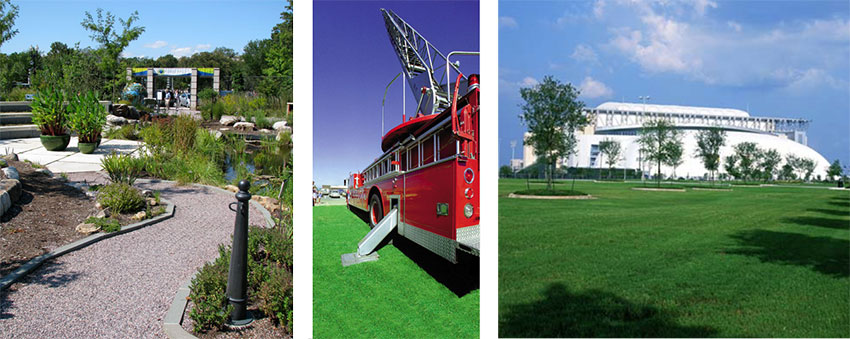
Photos courtesy of Invisible Structures
Porous paving is used in many different settings to provide, smooth, accessible, and environmentally conscious paving solutions for pedestrian and vehicular access.
COMPONENTS OF MODULAR PEDESTAL DECK SYSTEMS
As noted already, modular pedestal deck systems are versatile and can be incorporated into almost any project type to create usable, sustainable, and affordable outdoor spaces. They consist of standardized components that can be selected, specified, and customized to meet project needs, budget requirements, or green building goals. Regardless of where or how they are used, though, adjustable deck systems commonly incorporate three types of components as described in the following sections.
Deck Supports
Fixed or adjustable height pedestals are the fundamental support system for outdoor decks and have become recognized as one of the most labor- and cost-efficient methods of creating a level deck over a moderately sloped surface. High-density polypropylene plastic which is 100 percent recyclable is a common material used to manufacture the supports. This makes them impervious to water, mold, and freeze-thaw cycles. Their adjustability offers tremendous design flexibility compared to traditional deck-building materials and methods. Using a gravity system, the supports do not penetrate but rather protect roofing and waterproofing membranes thus causing no damage or harm to the surface below. The pedestals can be used to elevate the deck surface to meet the threshold, therefore providing an even and level transition from one space to another. This allows easy access for patrons with different levels of mobility.
The location of the pedestals is typically based on a modular layout that follows the size of the material used on the deck surface. Commonly, this is a 2-foot by 2-foot square grid, although many other sizes are possible as well. Adjustable pedestals are available in a range of heights and weight-bearing capacities to suit a variety of conditions or needs. Those decks carrying more weight or requiring more height to achieve a level condition will need a higher grade of pedestal. Residential-, commercial-, and industrial- grades each have different characteristics. Deciding which system to specify is dependent on the support and elevation requirements of the deck in a project. Wind uplift pedestal systems have been designed to resist high-velocity wind when installed to the manufacturer’s specifications. Adjustable pedestal systems can support decks over occupied space, allowing space for electrical systems, ductwork, and/or irrigation.

Photos courtesy of Kyle J Caldwell; Bison Innovative Products
Standard outdoor deck components can be customized and used very creatively to meet larger project goals as shown here at the Mass General Brigham Administrative Campus in Somerville, Massachusetts, designed by Gensler and OJB Landscape Architecture.
Deck Surfaces
The versatility of adjustable pedestal deck supports means that they can be used to elevate a variety of decking surface materials. The common options include pavers made from concrete or stone, such as granite or travertine. Similarly, structural porcelain tiles, fiberglass grating, composite materials, or conventional wood decking systems can be used in a grid pattern to meet different design requirements. Typically, a galvanized steel paver tray is adhered to the back of structural porcelain pavers or other materials prone to breakage to provide impact resilience and provide additional strength. The paver trays are available in a variety of standard sizes, compatible with large format ceramic tile sizes, and allow accommodation for thicknesses of 2 cm. With or without a support tray, the deck surface materials can be removed during building use for routine maintenance, repairs to the roof, or to gain access to other systems.
If a lighter-weight surface material is preferred or needed, then wood tiles are a good alternative weighing only one-third as much as concrete tiles. Typically made from hardwoods in a variety of species, wood tiles are generally commercial-grade products. If maintaining the wood color is desired, wood tiles can be periodically cleaned and sealed. Left to weather naturally, the wood tiles will develop a silvery-gray patina. Wood tiles can be crafted from premium-grade remnants and harvested in an environmentally responsible method designed to preserve the economic viability of rainforest hardwoods. Some manufacturers of wood tiles associate with governing groups such as the Forest Stewardship Council (FSC) to ensure the quality standards and practices of wood acquisition and plantation farming.
Site Furnishings
Manufacturers of pedestal deck systems also offer coordinated, modular elements that are designed to integrate with their deck systems while giving the architect complete design flexibility. Modular wood cubes are available with an array of design options to incorporate seating, storage, and planters. Such cubes are available with a polyurethane lining and drainage holes to host plant life. At other times of the year, the cubes can be repurposed for seating and storage of seasonal items (i.e., cushions and pillows) by placing a manufactured hardwood top on the cube.
If a different look is desired, aluminum cubes are also an option. Designed to withstand temperature extremes, these low-maintenance, durable planters are constructed of lightweight, partially recycled aluminum. Some use an industrial-strength powder-coated finishing process that is applied electrostatically and cured under heat, creating a more resilient finish than conventional paint. There are a variety of sizes and color choices available.
Overall, complete, coordinated, modular deck systems as described here, can be designed and specified to create attractive, durable, and sustainable outdoor spaces.

Photo courtesy of Greenscreen
Proper design, planning, installation, and maintenance are needed to keep the plants or vines alive after a living wall trellis system or other similar green infrastructure feature is set in place.
KEEPING LIVING WALLS ALIVE
The benefits of living walls are contingent upon keeping the plants or vines alive and thriving. When there is confusion between an artificial green wall and a true living wall, the design and specifications may not provide living plants or other necessary components such as irrigation and proper sunlight. The coordination of the design among the different disciplines and trades is needed to meet project goals or building owner expectations. Since the plants are living, everyone needs to recognize the need to work with nature and in so doing reap the biophilic and design benefits. Therefore, consider all of the following in the design, planning, installation, and maintenance phases of a living green facade or other living feature:
- Sun Exposure: At the outset, it is important to remember that the sun orientation for the plants is a key to their success. Different orientations or levels of sun exposure or shade may require different plant or vine selections.
Seasons of the Year: Everyone must understand the seasonal quality of the vines or plants being used in a design. Some plants may change colors in the fall or go dormant in the winter in certain climate zones. Therefore, managing owner expectations for off-season appearances can make a big difference in user satisfaction.Irrigation: Plants and vines need water to grow, so an irrigation system needs to be part of the design. Keep in mind that some irrigation systems that introduce fertilizer, may need a backflow prevention mechanism to avoid the fertilizer from getting into the main plumbing system.Soil: Healthy soil will be needed for the proper growth of the vines. The volume of soil will depend on the type of vines and their intended growth. The soil is incorporated at grade or in planters.Plant Species: Living green walls and other trellis-based living structures can be utilized with a wide variety of plant material. In general, twining vines such as jasmine, clematis, and honeysuckle work best. Vines that attach with adhesive suckers such as English Ivy, Boston Ivy, and Creeping Fig should NOT be used for wall-mounted applications as these vines will attach to the wall in addition to the trellis panels. It is best to consult with a trained landscape specialist to determine the species most likely to be successful for a particular project.Building Connection: Attaching the trellis system to a building wall requires proper detailing of the connections. For example, some wall types may need blocking for attaching a living wall trellis system.Maintenance: Maintenance is important to keep vines alive. It will begin the day that the vines are planted. Hence, the building owner should be advised on how to properly maintain the plants and should have a maintenance plan in place to ensure the project’s success.
By addressing the aforementioned points in the design and specifications, a fully functional system can be achieved delivering benefits that include mitigation of the urban heat island effect, stormwater management, and improved air quality.
CONCLUSION
Outdoor spaces require attention to design and are a key component of achieving project sustainability. By understanding different options for materials, systems, and strategies, the overall design and performance of these outdoor spaces can support and enhance their intended use and benefits to the people who use them.
Peter J. Arsenault, FAIA, NCARB, LEED AP, is a nationally known architect and a prolific author advancing better integration of site and building design. www.pjaarch.com, www.linkedin.com/in/pjaarch


